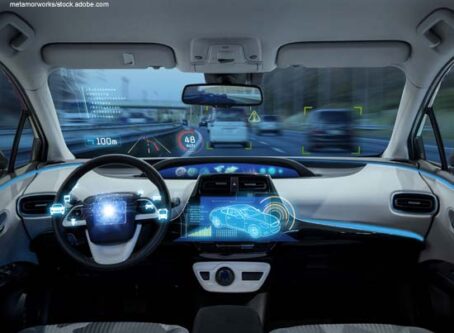Can front crash prevention systems reduce truck rear-end crashes?
A new study from the Insurance Institute for Highway Safety suggests front crash prevention systems could reduce 40% of truck rear-end crashes. However, the Owner-Operator Independent Drivers Association raises some concerns about the accuracy of the report.
On Thursday, Sept. 3, IIHS released a report assessing the effectiveness of front crash prevention systems in reducing large truck crash rates. According to the study, forward collision warning systems were associated with a 22% reduction in the rate of police-reportable crashes per vehicle miles traveled. Those systems also reduced rear-end crash rates of large trucks by 44%. Automatic emergency braking systems reduced overall crashes by 12% and rear-end crashes by 41%.
Front crash prevention systems use cameras, radar or other sensors to monitor the roadway ahead. Some include only forward collision warning, which alerts the driver to obstacles in the roadway. Automatic emergency braking systems take control away from the driver by automatically applying the brakes to prevent a collision or reduce its severity.
“(Forward collision warning) and AEB are effective countermeasures for crashes in which large trucks rear-end other vehicles,” IIHS concluded. “Large truck safety is expected to improve as new trucks are increasingly equipped with these systems. (Forward collision warning) has the advantage that some of these systems can be retrofitted to existing trucks, so benefits can be realized sooner and with less investment.”
The study looked into data from 62 carriers. Around 2,000 crashes that occurred over more than 2 billion vehicle miles traveled were examined. Less severe crashes were omitted from the study.
Neither forward collision warning nor automatic emergency braking systems are required to be installed in trucks or passenger vehicles in the United States. Most manufacturers are voluntarily including the technology in newer vehicles. However, the study could potentially move lawmakers to require the systems in all vehicles.
Concerns about efficacy of front crash prevention systems
Over the years, OOIDA has been quick to hit the brakes on so-called safety technology being mandated too soon. For example, the ELD mandate was pitched as safety technology. OOIDA argued that the data was never strong enough to prove the safety benefits of ELDs. Since the ELD mandate, large truck crashes have not improved. The Association is similarly cautious about front crash prevention systems.
To start, the more than 40% figure could be misleading. Andrew King, research analyst for the OOIDA Foundation, said of the 2,000 crashes studied, only 11% of those crashes were caused by a truck rear-ending another vehicle. In other words, front crash prevention systems worked in 40% of 11% of studied crashes.
“How many times did it actually prevent a crash?” King asks. “How many times did it actually reduce the severity of a crash? We don’t know. It just states this figure without explaining how they got there.”
According to U.S. Department of Transportation data, less than 3% of the more than 4,000 people killed in crashes involving a large track were the result of a truck rear-ending another vehicle. That data does not reveal who was at fault.
Truckers have complained about automatic emergency braking systems taking control away from the driver. Drivers have claimed that AEBs were activated when there was no threat, unnecessarily and suddenly reducing the truck’s speed. If a vehicle is behind a truck that suddenly brakes for no apparent reason, a crash could occur.
Also, the front crash prevention systems do not always work.
In fact, they do not activate most of the time. According to the study, forward collision warning systems were triggered in only 31% of crashes where the truck rear-ended another vehicle. That rate drops to 26% for automatic emergency braking systems with auto brakes. One issue with advanced driver-assistance systems is that drivers can put too much confidence in the technology. This has been exhibited with Tesla’s Autopilot system and drivers believing the technology can do more than it can, resulting in sometimes fatal crashes.
Data missing from the study include who was driving. Although the study mentions 62 carriers participated, those carriers are not named. Information such as operation type, average length of haul and safety records could affect crash rates for any carrier. Furthermore, driver demographics could play a major role in crash prevention. Specifically, were the drivers older or younger and how many years of driving did they have under their belt?
Weather, time of day, length of haul, location, speed limits, etc. were also not mentioned in the study. Those factors have proven to have a correlation with crash rates as well.
In response, OOIDA also raises questions about claims of systems reducing crash severity and speed, considering the small sample size.
Specifically, the Association points out that claims that forward collision warning systems may reduce the speed of a truck involved in a crash is based on five crashes taken from a three year period.
“It hardly seems reasonable to make safety recommendations for an entire industry based on five crashes,” OOIDA said in a statement. “While it may be tempting to accept IIHS’s claims and accept AEB and (forward collision warning) as an easy way to improve highway safety, the truth is not so simple. Before promoting systems that take control of a truck out of a driver’s hands, Congress should listen to the concerns that drivers have raised about these systems, including false or unexpected system activation, which can create its own hazards. Further evaluation of these technologies in practical driving settings is clearly needed.”
During the Federal Motor Carrier Safety Administration’s 2020 Truck Safety Summit, Ritchie W. Huang, Daimler Trucks North America’s executive manager of advanced safety systems and autonomous driving, addressed advanced driver-assistance systems, which includes forward collision warning and automatic emergency braking systems.
Huang stated that although Daimler Trucks has in-house AEB systems and launched the first Level 2 truck in North America, he still acknowledged that the technology is not perfect. Advanced driver-assistance systems technology is still in the early stages and needs “refinement,” Huang said during the summit.









